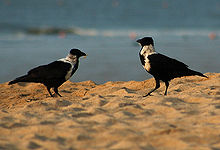| This article needs additional citations for verification. Please help improve this article by adding citations to reliable sources. Unsourced material may be challenged and removed. Find sources: "Collared crow" – news · newspapers · books · scholar · JSTOR (September 2024) (Learn how and when to remove this message) |
| Collared crow | |
|---|---|

| |
| Conservation status | |
 Vulnerable (IUCN 3.1) | |
| Scientific classification | |
| Domain: | Eukaryota |
| Kingdom: | Animalia |
| Phylum: | Chordata |
| Class: | Aves |
| Order: | Passeriformes |
| Family: | Corvidae |
| Genus: | Corvus |
| Species: | C. torquatus |
| Binomial name | |
| Corvus torquatus Lesson, 1831 | |

| |
| Global range | |
| Synonyms | |
| |
The collared crow (Corvus torquatus), also known as the ring-necked crow or white-collared crow, is a member of the family Corvidae native to China and north of Vietnam.
Description
It is about 52–55 cm in length—the same size or slightly larger than the carrion crow (C. corone), with proportionately slightly longer wings, tail and bill. A sleek and handsome bird, it has glossy black plumage except for the back of the neck, upper back (mantle), and a broad band around the lower breast that is white. The bill, legs and feet are black.
It sometimes flies with its feet hanging down below the body in a characteristically "lazy" way.
The voice is a loud "kaaar" repeated several times with other slight variations on it to suit the occasion. It also like many other corvids, utters strange clipping and clicking sounds during its head bowing display to another bird.
Distribution and ecology
The range of this species is essentially China, covering large areas of the country though not further north than Beijing. It occurs in plains and low lying river valleys in fairly open country and cultivated regions and is a common sight in paddy fields. It tends to avoid large towns and cities and is predominantly a rural species.
Food is sought mainly on the ground where a large range of items are taken, such as insects, mollusks and other invertebrates (even from shallow water), grains, especially rice and it also searches among refuse for suitable food items left by humans. It appears to take less carrion than other species but will if the opportunity arises, and will also take eggs and nestlings.
The nest is usually in a tree and is plastered with mud. There are usually 3–4 eggs laid.
It was classified as least concern by the International Union for the Conservation of Nature in 2004 before being upgraded to near threatened status in 2008. It is considered a vulnerable species as of 2018.
References
- ^ BirdLife International (2018). "Corvus pectoralis". IUCN Red List of Threatened Species. 2018: e.T22706049A131735892. doi:10.2305/IUCN.UK.2018-2.RLTS.T22706049A131735892.en. Retrieved 14 September 2024.
External links
- Explore Species: Collared Crow at eBird (Cornell Lab of Ornithology)
| Taxon identifiers | |
|---|---|
| Corvus torquatus | |